Bill D. (VA)
Silver Member
Yesterday I returned to the new site where I’ve had a lot of success recently. I brought along my good friend Reid to hit the small 1600s spot that me and my buddies have pounded recently. But it still continues to produce if you have the patience to swing through the extremely tall and thick clover and pursue those deep, questionable signals. In an attempt to gain an advantage I decided to think outside the box a bit and try a technique that I’ve considered many times before, but just never got around to it. We got a half sheet of plywood, cut 2 small holes in one side, and attached a length of cord to it that extended out about 2-3 feet. The plywood would be placed over a patch of thick clover, and then pushed down with our feet to allow detecting much closer to the ground. Then by pulling on the cord the plywood could be quickly re-positioned and the process repeated. This turned out to be a very quick and effective way to handle the tall clover and cover ground quickly, and allowed many additional targets to be identified. Reid took a short 1 minute video of me demonstrating this technique which can be found at the link below.
https://youtu.be/75Slxi4yFZs
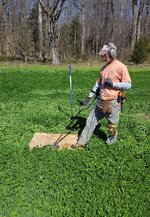
About halfway into the hunt Reid chased a very deep, iffy signal through the plywood and ended up recovering the first coin to come from this spot – a nice little Spanish cob. Near the end of the day I was able to dig a cool 17[SUP]th[/SUP] century merchant’s token with the initials “CL” and the date 1652 on the obverse, and “Bristoll” on the back. This is very similar to a 1670 token I dug this time last year on an adjoining property, and I’m really curious as to how these made it over to Virginia and what purpose they would have served here.
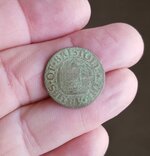
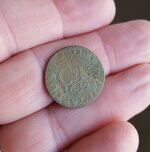
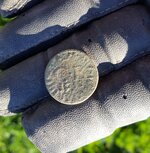
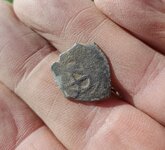
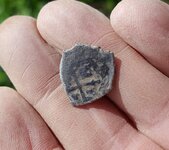
Some of my other finds included a few 17[SUP]th[/SUP] century leather ornaments including the stylized arrow, tudor rose, and high dome styles. I also found a very large bore clay pipe stem, and a few misc lead and small brass items. Reid also found some buttons and a few 1600s buckle fragments along with other period items. Right before leaving while Reid was investigating a deep iron signal, he stumbled across a trash pit although it seems to be more 18[SUP]th[/SUP] century based on some pottery and a button that were found. It had a nice use layer and was also loaded with huge bricks of various shapes and sizes, and extended down at least 2 feet. It also appeared to continue horizontally but it was getting late and we had to fill it in, but we plan to go back one day next week and finish the job. All-in-all it was a fun day as both of us were able to bring home a real nice keeper.
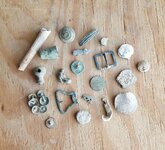
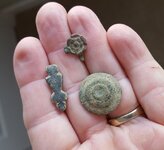
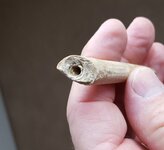
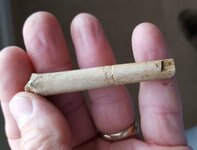

https://youtu.be/75Slxi4yFZs

About halfway into the hunt Reid chased a very deep, iffy signal through the plywood and ended up recovering the first coin to come from this spot – a nice little Spanish cob. Near the end of the day I was able to dig a cool 17[SUP]th[/SUP] century merchant’s token with the initials “CL” and the date 1652 on the obverse, and “Bristoll” on the back. This is very similar to a 1670 token I dug this time last year on an adjoining property, and I’m really curious as to how these made it over to Virginia and what purpose they would have served here.





Some of my other finds included a few 17[SUP]th[/SUP] century leather ornaments including the stylized arrow, tudor rose, and high dome styles. I also found a very large bore clay pipe stem, and a few misc lead and small brass items. Reid also found some buttons and a few 1600s buckle fragments along with other period items. Right before leaving while Reid was investigating a deep iron signal, he stumbled across a trash pit although it seems to be more 18[SUP]th[/SUP] century based on some pottery and a button that were found. It had a nice use layer and was also loaded with huge bricks of various shapes and sizes, and extended down at least 2 feet. It also appeared to continue horizontally but it was getting late and we had to fill it in, but we plan to go back one day next week and finish the job. All-in-all it was a fun day as both of us were able to bring home a real nice keeper.





Last edited:
Upvote
45










